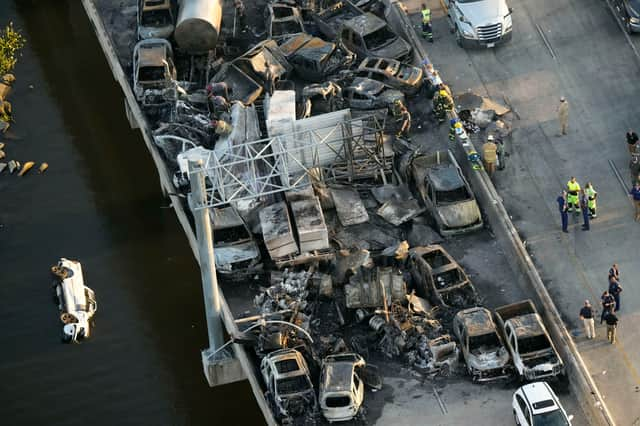Superfog: What is the rare weather phenomenon that caused USA car pileup, what other types of fog are there?


At least seven people have been killed and many more injured after around 160 vehicle were involved in a series of crashes near New Orleans, in the American state of Louisiana.
A type of particularly thick 'super fog' was blamed for the smash, which left a long stretch of mangled and scorched vehicles on Interstate 55.
Advertisement
Hide AdAdvertisement
Hide AdHere's what causes the dangerous weather condition - and the other types of fogs recognised by meteorologists.
Super Fog
While it's not a term used by the UK Met Office, the USA's National Weather Service says that super fog "forms when a mixture of smoke and moisture released from damp smoldering organic material such as brush, leaves and trees, mixes with cooler, nearly saturated air."
It can cause visibility to be lowered to less than 10 feets and meanders through low terrain areas, including roads - where it has in the past been the cause of several multi-vehicle pileups
In Louisiana, the super fog was caused by already-dense morning fog combining with smoke from nearby marsh fires.
Radiation fog
Most commonly forming during calm and clear days in winter, radiation fog occurs when the land and the air close by cools overnight, reducing the ability of the air to hold moisture. This allows the condensation that causes fog to form.
It usually vanishes after sunset when the ground - and air - starts to warm up.
Valley fog
Often creating stunning views, valley fog forms where cold air sinks into a valley. Fog forms in the lower parts of the valley, while there can be clear conditions just a few feet above where the air is warmer (the technical term being a temperature inversion).
Valley fog can last for several days in calm conditions during the winter.
Advection fog
Advertisement
Hide AdAdvertisement
Hide AdVery common on the east coast of Scotland, advection fog occurs when moist, warm air passes over a colder surface and is cooled. This cool surface may be snow-covered land or a body of cold water. The fog may then be blown by winds over surrounding areas.
Upslope fog
When wind blows up a slope, the air cools the higher it rises. This cooling causes moisture to condense, forming the hill fog.
Evaporation fog
Caused by cold air passing over warmer water or moist land, evaporation fog can also create freezing fog and cause frost to form.
It forms when some of the the warmer water evaporates, mixes with the cooler air and condenses.
It can be incredibly localised and can be caused by a relatively tiny area of warm water such as a swimming pool or hot tub.
Haar
A familiar sight to residents of the Lothians and Fife, haar is a Scottish term for a particualar type of coastal advection.
Most common in spring and summer, it can ruin what would otherwise be a warm and sunny day, forming when warm air moves over the cool surface of the North Sea towards the east coast.
As the Met Office explains: "The cold air just above the sea's surface cools the warm air above it until it can no longer hold its moisture. This forces the warm air to condense, forming tiny particles of water which forms the fog that we see."
Advertisement
Hide AdAdvertisement
Hide AdAs the sea gets warmer towards the end of summer, the less likely it is that a haar will form.
In eastern England, the coastal fog is referred to as fret.
Freezing Fog
Usually created by evaporation fog, freezing fog forms when the temperatures are below freezing. The tiny water droplets that the fog is made up of are supercooled and remain liquid as they have no supface to freeze onto.
Comments
Want to join the conversation? Please or to comment on this article.